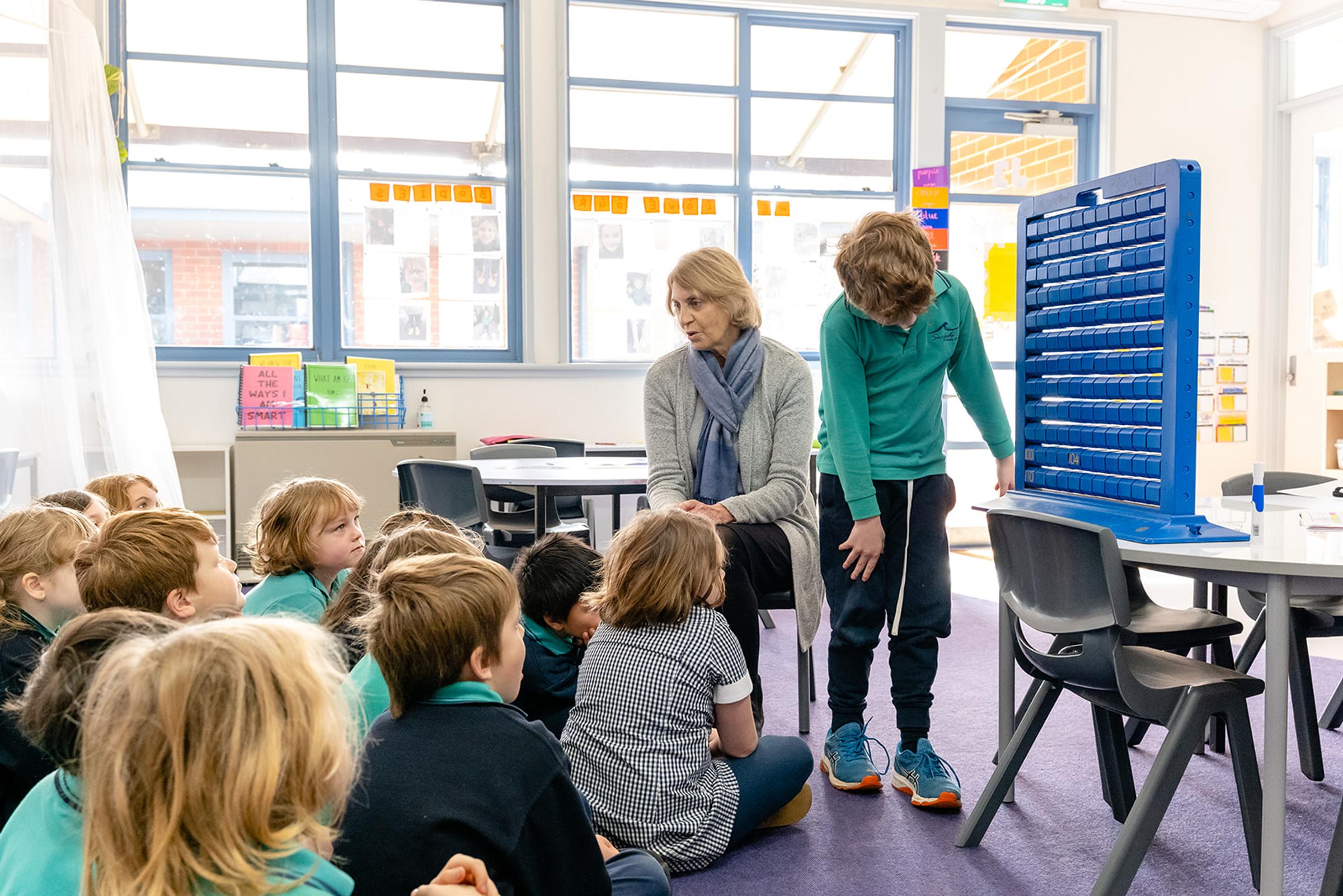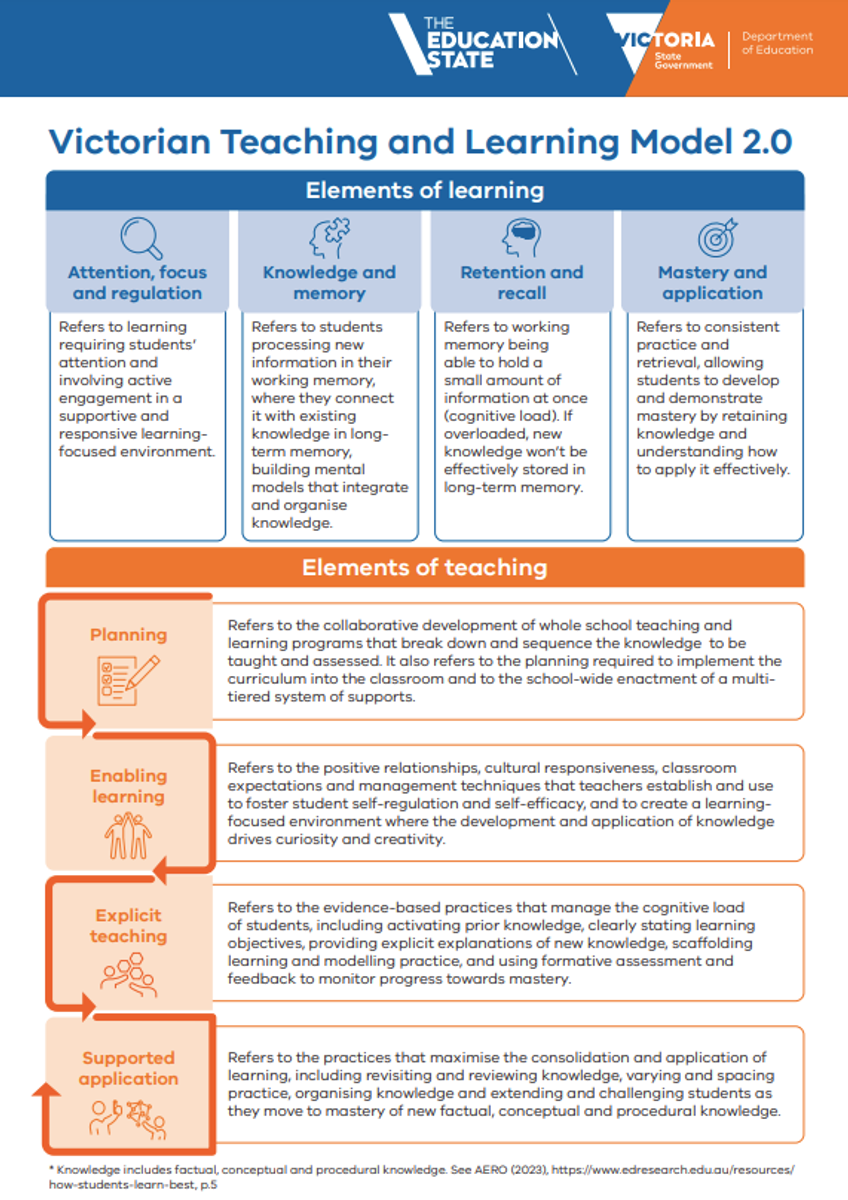Teaching & Learning Page

Department of Education Victorian Teaching and Learning Model 2.0
The Department of Education has recently launched a number of supports for schools to implement a current change in practice. At Surfside we are lucky as this now supplements our current way of teaching and won't be anything new for us to implement. The below is a resource that describes the new Victorian Teaching and Learning Model:
Overview
The Victorian Teaching and Learning Model 2.0 (PDF, 414KB) (VTLM 2.0) is a revision of the original VTLM based on the most recent evidence and school-based practice.
The department developed the VTLM 2.0 in consultation with the Australian Education Research Organisation (AERO).
All Victorian government schools are working to embed the VTLM 2.0 in their teaching and learning programs from the start of the 2028 school year.
Structure of the VTLM 2.0
The VTLM 2.0 introduces an emphasis on the evidence about how students learn as the basis for effective teaching. It provides increased clarity for teachers about the elements of teaching that have the strongest evidence base. The VTLM 2.0 links to best practice approaches from existing departmental frameworks that contribute to effective student wellbeing and classroom management, such as the Positive Classroom Management Strategies (PCMS).
The VTLM 2.0 consists of 2 major elements:
- Elements of learning – the process of human learning, based on cognitive science, neuroscience and education psychology.
- Elements of teaching – representing the evidence-based teaching practices that most effectively support learning: planning, enabling learning, explicit teaching and supported application.
Elements of learning
The 4 elements of learning in the VTLM 2.0 are based on insights into the process of learning from cognitive science, neuroscience and education psychology.
The 4 elements of learning in the VTLM 2.0 represent these key findings from the evidence-base:
- Attention, focus and regulation: Learning requires students’ active engagement and focused attention in order to move new information from working memory to long-term memory. Student learning can be supported by minimising distractions, setting appropriate levels of challenge, using rules and routines, and establishing learning environments where students feel accepted, valued and that they belong.
- Knowledge and memory: Working memory is the active workspace for engaging with knowledge, skills and concepts. Learning happens when new knowledge moves from working memory to long-term memory. Long-term memory is where information, including our memories, are stored and new knowledge is linked to existing mental models.
- Retention and recall: As working memory has limited capacity, it is best supported if new information is introduced in small, manageable chunks, a task is not too difficult for the current level of knowledge, there are no visual or auditory distractions and there are clear expectations and consistent rules and routines. Practice using new information facilitates transfer to long-term memory and retention. Recalling new knowledge strengthens the connections in long-term memory and makes it easier to apply.
- Mastery and application: Spaced, varied and repeated practice consolidates learning, builds neural connections, supports transfer of learning to new situations and leads to ever more complex mental models in long-term memory. This in turn supports retrieval and application of knowledge. Students can more effectively engage in problem solving and generate new learning once they have acquired the relevant knowledge.
Elements of teaching
The 4 elements of teaching in the VTLM 2.0 are Planning, Enabling Learning, Explicit Teaching and Supported Application.
Each of the VTLM 2.0’s 4 elements of teaching cascades down into 3–5 strategies. The following example outlines an element of teaching and strategies located within it.
Strategies in the explicit teaching element
Practices located within this element of teaching include:
- Focus the learning
- Explicit explanation and modelling
- Scaffold practice
- Monitor progress.
Explicit teaching – an overview
The VTLM 2.0 has explicit teaching practices at its core. Evidence demonstrates that explicit teaching practices are most effective at delivering strong learning outcomes for the majority of students, including priority cohorts.
Explicit teaching is an evidence-based approach to teaching that is designed to manage the cognitive load of students as they learn new content. It involves fully explaining and effectively demonstrating what students need to learn.
Explicit teaching also involves being clear about learning objectives, building on students’ existing knowledge, providing new knowledge in manageable ‘chunks’, scaffolding learning, modelling practice and providing clear feedback to students as they apply their new knowledge and practise new skills. The Australian Education Research Organisation (AERO) describes explicit teaching like this:
'Teachers directly explain to students how to complete a task, why the task is important, and how the task relates to and extends their previous knowledge. Demonstrations of how to perform tasks or solve problems are provided, often using worked examples. Regular checks for understanding are undertaken to allow teachers to identify and address misconceptions and support students’ learning progress.'
Explicit teaching is not all teacher talk. At its best, it is a high participation model. In practice, it includes implementing techniques such as:
- activating prior knowledge and ensuring that it is sound enough to build on
- stating clear learning objectives (informed by the curriculum)
- providing explicit explanations of new knowledge in manageable ‘chunks’
- using the “I do, we do, you do” technique, for example by:
- modelling new learning through worked examples
- scaffolding learning by providing opportunities for students to practise with timely corrective feedback
- providing opportunities for students to apply their new knowledge, practise new skills and deepen their understanding
- interacting with your students as they practise, providing prompts and additional scaffolds as required.
- modelling new learning through worked examples
Many Victorian government schools are already achieving strong learning outcomes using explicit teaching.

